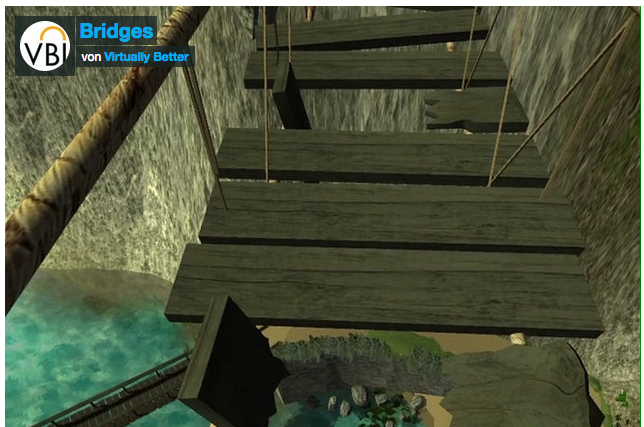Embodied Interaction HS2016
Virtual Reality Therapy
Bild credits: Fear of Heights (Bridges), virtuallybetter.com
Most of us experience some level of stress and anxiety in our lives. It can be relatively mild or extremely severe and debilitating — or anywhere along the spectrum. Some examples include general stress at work, relationship issues, fears and phobias, depression and other anxiety disorders, including post-traumatic stress disorder (PTSD).
Virtual reality therapy (VRT) uses specially programmed computers, visual immersion devices and artificially created environments to give the patient a simulated experience that can be used to diagnose and treat psychological conditions that cause difficulties for patients.
In many environmental phobias, reaction to the perceived hazards, such as heights, speaking in public, flying, close spaces, are usually triggered by visual and auditory stimuli. In VR-based therapies, the virtual world is a means of providing artificial, controlled stimuli in the context of treatment, and with a therapist able to monitor the patient's reaction.
Virtual reality (VR) has been used for decades as a tool for therapists to administer virtual reality exposure therapy (VRET) in a safe and controlled manner. Due to cost and technology limitations, it has not been widely available, to date. With the advent of affordable mobile VR headsets, such as the Gear VR, there is a new opportunity to apply telemedicine to decentralize mental health treatment, reaching more patients and improving lives around the world.
Research Questions
- What kind of environments and interactions can we imagine and create to support (or create) VR therapy (other than those projects already existing, see below)?
- What are the requirements for these environments and interactions so that they are meaningful and productive for the patient and therapist?
- What are hurdles and challenges to overcome for interaction designers when building an experience prototype for Virtual Reality Therapy?
Input
- Wikipedia: Virtual Reality Therapy
- Stefanie Schramm - Hypnosystemic Crisis Intervention and Support
- Edward T. Hall - The Hidden Dimension
- Handout Workshop Embodied Interaction (Therapeutic Gaming)
Related projects
Exposure Therapy
- https://en.wikipedia.org/wiki/Exposure_therapy
- https://techcrunch.com/2016/01/06/virtual-reality-therapy-treating-the-global-mental-health-crisis/
- https://www.scientificamerican.com/article/virtual-reality-headset-is-reinventing-exposure-therapy/#
- http://ict.usc.edu/pubs/Development%20and%20early%20evaluation.pdf
Projects
- http://phobos.psychologicaltechnologies.com/blog/
- http://ict.usc.edu/prototypes/pts/
- http://www.vrphobia.com/products.htm
- http://www.virtuallybetter.com/portfolio/fear-of-heights-bridges/
- http://clevr.net/portfolio#descalator
- https://www.psious.com/#sec-intro
- http://www.virtualret.com/en/virtual-environments/
- http://owenllharris.com/deep/
- http://www.unellodesign.com/
- http://www.wearewearables.com/
Deliverables
- Individual Research (Discussion Round) (Tuesday 29.11)
Please post found projects in the following Google Docs for sharing. - Concept Illustration (Concept Presentation) (Friday 2.12)
Each group submits a concept illustration in the form of a video (1-2 minutes). - Experience Prototype (Final Presentation) (Thursday 22.12)
Each group submits a working experience prototype as well as a video illustrating the final concept embedded in a story. - Documentation (Delivery) (Friday 23.12)
Each group submits a documentation of their work that includes images, textual documentation (process & reflection).
Schedule
| Week 1 | Tuesday 22.11 | Wednesday 23.11 | Thursday 24.11 | Friday 25.11 |
|---|---|---|---|---|
| Morning | Kick-Off | Individual Research | Individual Research | Tech 1 |
| Afternoon | Lecture Marcus Body-Storming Session | Tech Intro JG - 4.T48 | Ausflug Wil MR, MF (~12.00) | |
| Week 2 | Tuesday 29.11 | Wednesday 30.11 | Thursday 01.12 | Friday 2.12 |
| Morning | Individual Research | Input Marcus MR, MF, JG, MC - 4.T48 (09.00) | Group Work | Concept Presentation MR, MF, JG - 4.K14 (09.00) |
| Afternoon | Discussion Round MR, MF, JG - 5.F12 (13.00) | Group Work | Short-Mentoring MR, CW | Mentoring MR, MF, JG, CW |
| Week 3 | Tuesday 6.12 | Wednesday 7.12 | Thursday 8.12 | Friday 9.12 |
Morning | Tech 2 JG, RS - 4.T48 | Group Work | Group Work | On-Demand Mentoring |
| Afternoon | Group Work | Mentoring MR, MF, JG, CW | Group Work | |
| Week 4 | Tuesday 13.12 | Wednesday 14.12 | Thursday 15.12 | Friday 16.12 |
Morning | On-Demand Mentoring | Group Work | On-Demand Mentoring | Group Work |
| Afternoon | Group Work | Mentoring MR, MF, JG, CW | Group Work | |
| Week 5 | Tuesday 20.12 | Wednesday 21.12 | Thursday 22.12 | Friday 23.12 |
Morning | On-Demand Mentoring | Group Work | Final Presentation MR, MF, JG, CW - 4.T48 (09.00) | Documentation |
| Afternoon | Group Work | Mentoring MR, MF, JG, CW | Feedback MR, MF, JG - 4.T48 |
MR: Max Rheiner, MF: Martin Feuz, JG: Joël Gähwiler, CW: Christine Wyss, RS: Reto Spoerri, MC: Marcus Cheetham
